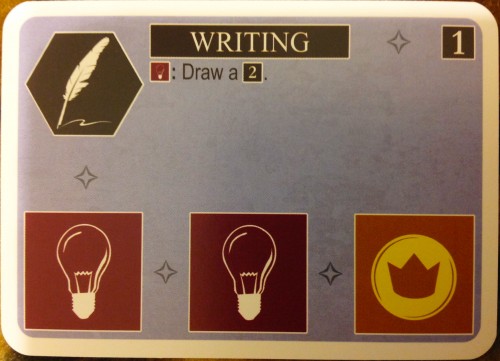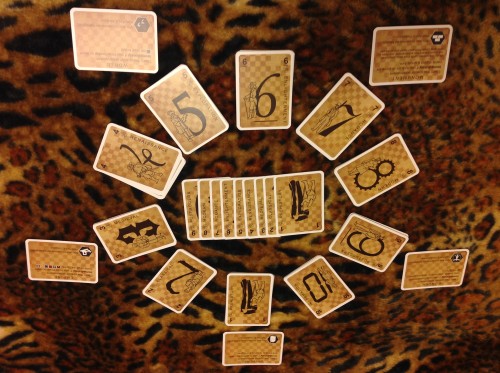Innovation by Carl Chudyk
 Innovation
Innovation
by Carl Chudyk
Asmadi Games, 2010
$25 Buy from Amazon or Asmadi Games or try online at Isotropic
Writing [Blue/Age 1/Bulb]: Draw a 2.
It doesn’t look like much on its own, but that small amount of information tells you everything you need to know about one of the most monumental achievements in human history. It’s just one example of 105 concepts and technologies represented in Carl Chudyk’s clever (and occasionally revelatory) minimalistic card game Innovation.
Of course, being as it is an exploration of the march of human progress from Prehistory through the Information Age, Innovation is minimalistic only on its surface. The goal of the game, reduced to its simplest format, is to harness these advancing concepts to steer your culture (represented by a tableau of cards in front of you) toward monumental achievements—specifically, more and faster achievements than the other players. Ideas from The Wheel to The Internet are represented by the intersection, on a single card, of four very simple elements: a color (one of five, which might be thought of as the card’s suit); a value (the age, 1-10, that the invention hails from); a “dogma” effect, which can be called upon once the card has been “melded,” or put into play; and three icons, of one or more of 8 types, arranged around the bottom-left borders of the card like a supine L.
In play, the clipart-style icons and mostly solid colors make Innovation redolent of a child’s educational toy. From the outside, that is. In play—that is, to those actually experiencing the game—Innovation‘s minimalistic trappings hide a maximalistic struggle as epic as history itself.
 Let’s take another look at Writing, for example. It’s an Age 1, or Prehistoric, technology. During setup, stacks representing all 10 Ages of history, each holding roughly 10 cards, are arranged in order. All players begin in Age 1, and can only begin drawing cards from the later ages once the Age 1 draw pile is depleted or if they have melded (added to their tableau) a technology from a later age. Since cards from later ages are almost universally more valuable than earlier ones, this makes that simple Writing technology, whose only effect is “Draw a 2”, the key to unlocking a host of strategic choices for the lucky player who draws it early in the game. While the other players are stuck in the Stone Age, discovering important but rudimentary technologies like Sailing, Pottery and Domestication, you can be drawing Age 2 (Classical era) technologies such as Mapmaking, Currency and Mathematics.
Let’s take another look at Writing, for example. It’s an Age 1, or Prehistoric, technology. During setup, stacks representing all 10 Ages of history, each holding roughly 10 cards, are arranged in order. All players begin in Age 1, and can only begin drawing cards from the later ages once the Age 1 draw pile is depleted or if they have melded (added to their tableau) a technology from a later age. Since cards from later ages are almost universally more valuable than earlier ones, this makes that simple Writing technology, whose only effect is “Draw a 2”, the key to unlocking a host of strategic choices for the lucky player who draws it early in the game. While the other players are stuck in the Stone Age, discovering important but rudimentary technologies like Sailing, Pottery and Domestication, you can be drawing Age 2 (Classical era) technologies such as Mapmaking, Currency and Mathematics.
And once you have Mathematics in hand…oh, the places you’ll go then. Like Writing, Mathematics is a blue card with 2 bulb icons and 1 crown icon. Unlike Writing, it is an Age 2 technology, which means that as soon as it’s melded into your culture, you can draw from the Classical era’s suite of concepts even without Writing’s culture-advancing abilities. In fact, you couldn’t use Writing anymore if you wanted to; when you put Mathematic into play, you placed it on top of a stack of all other technologies of the same color you had previously discovered, burying them and making their dogma effect unusable. You could say that the advent of Mathematics pushed Writing out of the limelight. It’s still a part of your culture, but for now, its effects are dormant.
That doesn’t matter, though, because Mathematics’ dogma effect is even more powerful than Writing’s. It reads: “You may return a card from your hand. If you do, draw and meld a card of value one higher than the card you returned.” Again, this might not look like much at first. But let’s not forget the reason you melded Mathematics in the first place: you always get to draw from the age matching the highest-value card (determined by the card’s Age) in your culture. So you can use Mathematics to discard another Age 2 technology, like Monotheism (who needs religious mystery in the age of rationalism?) and replace it with something from Age 3 (the Medieval era)—say, Engineering. On your next turn, you can draw a new Medieval card, then immediately exchange it for something from Age 4, the Renaissance. And you can keep doing this to rocket through the ages, one turn at a time, discovering Banking and Refrigeration and Quantum Theory while your rivals are still puzzling out Road Building.
Tread cautiously, though. While early technologies are slow but stable, later technologies can be volatile. Even Writing, while it doesn’t provide the same rocket boost as Mathematics, has the advantage of being somewhat more contemplative and circumspect. With Mathematics, you must meld the card that you drew, even if it buries another technology you would rather have. Writing is slower, but it allows you to examine and judge for yourself exactly how and when to put your ideas into action.
February 17th, 2014 / 11:00 am


